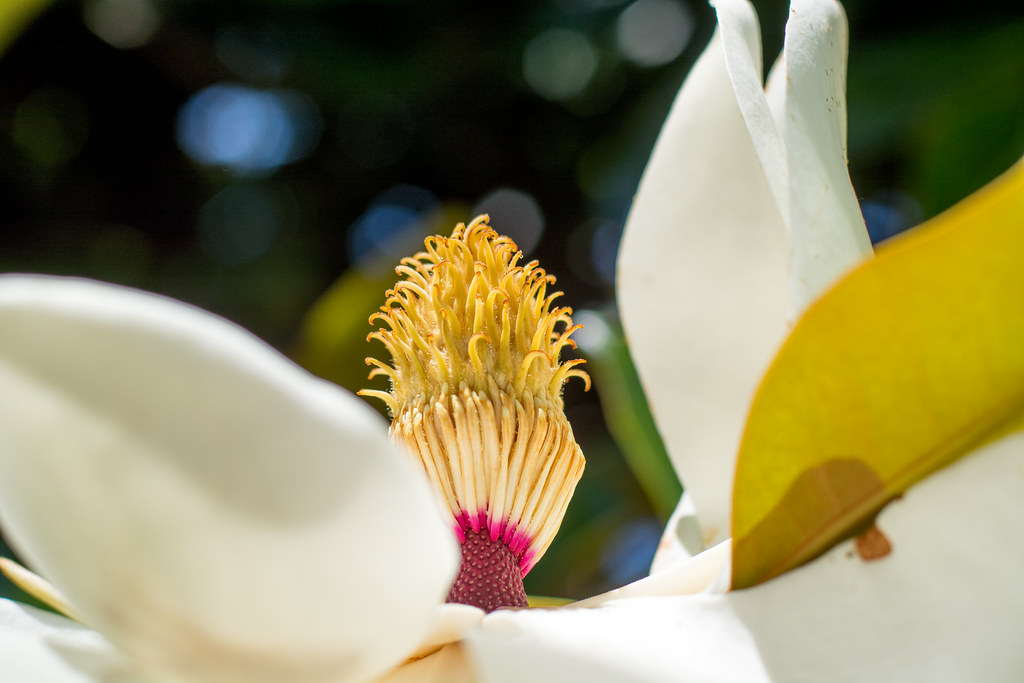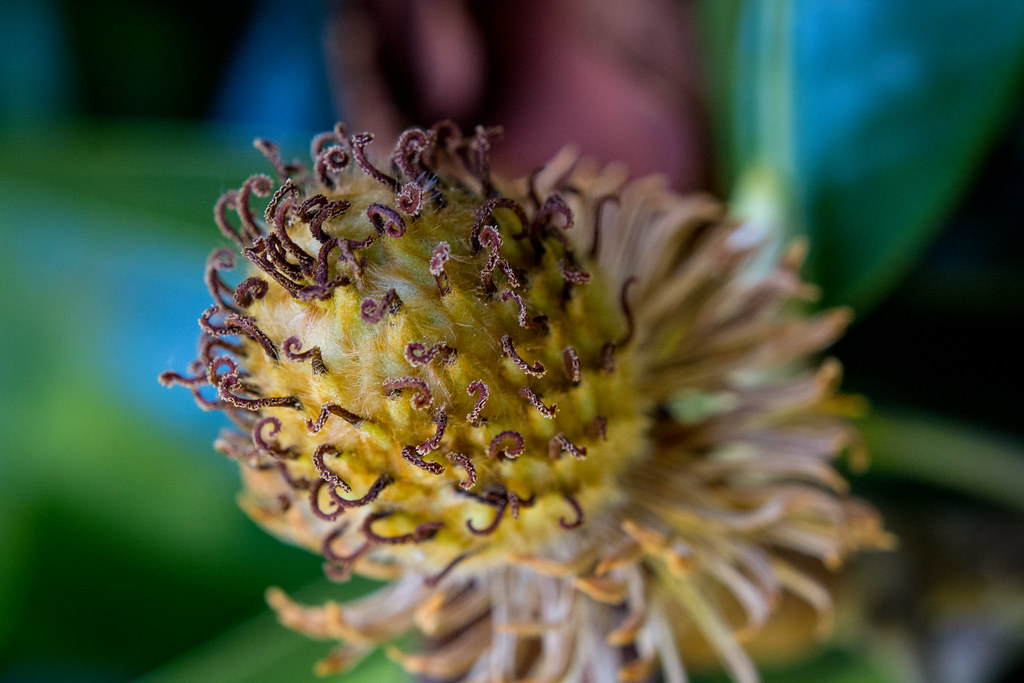This photo came about somewhat by accident, and not really how I intended, but led to a series of images of which I am rather fond nonetheless. I have posted some pictures over the years involving magnolia trees, which are quite prevalent here in this part of Oklahoma, and the beauty of their flowers never stops being amazing to me. I hope, then, that you won’t mind yet another photo (or two or three) of the same subject :)
When I shot this picture I was on a short walk and wasn’t really looking for an image quite like what you see, but I did know I wanted to capture a magnolia flower somehow using my D7100 and a close-up filter. (I think might have been either a +4 or a +10 but can’t remember which.) Not 30 seconds into the walk I came across this flower which was just starting to emerge, and as I took a few shots I specifically framed the subject so it was being blocked a bit on the left-hand side by one of its own massive petals. I wanted to create a scene almost as if the viewer is peeking in on the beginning of something fascinating not unlike when a baby raptor emerges from its egg in the original Jurassic Park. Though hopefully this flower is much more benign.
I thought the image was decent but kept on looking around for something…different. On another tree I spotted this flower which was much farther along in its progression:
 For this image I removed the filter so I could get a little more context for the flower. I wanted to see some of the petals and surrounding scenery which wasn’t really possible with a close-up filter attached. I shot from a low angle because I thought it would be more appropriate to see this flower reaching, stretching, lifting high into the sky like Andy Dufresne at the end of Shawshank. (Though ironically, that scene was shot from above in kind of the opposite fashion. Hmm. Perhaps I need to re-think my technique.) It made no sense to use a filter on the second image because it would have severely restricted my field of view and given the viewer no sense of context at all, and I liked the idea of showing the petals opening wide as the ball of pistils raised the anthers high almost like a chorus of worshippers praising God on a Sunday morning. In his gospel Luke recounts a scene in which Jesus tells the religious leaders of the day that if his disciples are not allowed to speak, the rocks and stones around them will cry out with praises to the Lord. I don’t know if they had magnolia trees in Israel back then, but it sure looks to me like that’s what is happening here in this picture :)
For this image I removed the filter so I could get a little more context for the flower. I wanted to see some of the petals and surrounding scenery which wasn’t really possible with a close-up filter attached. I shot from a low angle because I thought it would be more appropriate to see this flower reaching, stretching, lifting high into the sky like Andy Dufresne at the end of Shawshank. (Though ironically, that scene was shot from above in kind of the opposite fashion. Hmm. Perhaps I need to re-think my technique.) It made no sense to use a filter on the second image because it would have severely restricted my field of view and given the viewer no sense of context at all, and I liked the idea of showing the petals opening wide as the ball of pistils raised the anthers high almost like a chorus of worshippers praising God on a Sunday morning. In his gospel Luke recounts a scene in which Jesus tells the religious leaders of the day that if his disciples are not allowed to speak, the rocks and stones around them will cry out with praises to the Lord. I don’t know if they had magnolia trees in Israel back then, but it sure looks to me like that’s what is happening here in this picture :)
As I rounded the tree I came upon one final scene that shows the progression of a magnolia flower, and even though the beauty and glory has faded there is still much to be seen.
 The anthers are withered, the pistils are faltering, and yet despite the impending sense of loss and decay there is hope to be found here as the flower has served its purpose, and in its death there lives hope: inside the ball of pistils are dozens of bright red seeds only beginning to take form, and in a few months what was once a flower will be transformed into a thick green shell which will house them until they are fully mature. After that the shell itself will wither and die, exposing the seeds which may take root and turn into majestic trees of their own someday.
The anthers are withered, the pistils are faltering, and yet despite the impending sense of loss and decay there is hope to be found here as the flower has served its purpose, and in its death there lives hope: inside the ball of pistils are dozens of bright red seeds only beginning to take form, and in a few months what was once a flower will be transformed into a thick green shell which will house them until they are fully mature. After that the shell itself will wither and die, exposing the seeds which may take root and turn into majestic trees of their own someday.
I wasn’t expecting to capture all this on a single 10-minute walk one warm May afternoon, but that’s the nice thing about photography. You never know what you’re gonna get.

RoSeTta says
Splendid and backdrop stories. In health Simon. Have a magical day!
Simon says
Thank you, Rosetta! I’m glad you liked the photos, and I will surely do my best to have a magical day today…as long as you do too! :)
David says
Simon —
Class was outstanding today! I love how you used a series of pictures to tell the story of the birth, life, death, and regeneration of the flora you observed. The use of the macro filters has imparted a completely new facet to your post. I especially liked how you went away from macro to take photo #2. All that aside, I want you to know that today’s photos, and commentary, fill me with the joy of life — a joy made abundant because I have accepted Jesus Christ as my Lord and Savior.
Simon says
David, reading your comments always makes me smile :) I’m so glad you enjoyed seeing these photos and the transition between the various stages of life, and you’re right–in Christ Jesus we all have new life!
William Matthey says
Very nice!
Simon says
Thanks William!
Dennis W. says
Simon,
Thanks for your exploration of this subject. It illustrates the need to keep looking at a subject to find additional views and better photographs. When I am out photographing nature, I often say to myself, “What God hath wrought!” There seems to be no end to the beauties around us if we will just take the time to observe.
Earlier in the month, I bought a 50mm lens and am enjoying the experience and adjusting to the fact that it does not zoom. Thanks for your continued encouragement by sharing your experiences.
Simon says
I think the same thing to myself as well, Dennis. Sometimes even just a simple walk around the block (or back yard) can show just how incredible the wonders of God’s creation truly are. There’s so much to see and take in, if only we stop to notice it :)
I’m sure you will like that 50mm lens, and if you have any shots of your own to share I’d love to see them!
Rebecca Burlingham says
Dang the FOCUS on that last one!
Simon says
Awww…thanks Rebecca! It sure is fun playing with these close-up filters :)
Cindy Grohs says
Live your photos and appreciate your messages containing God’s word! What I can’t understand is what a close up filter is? I have tried to google it but only find close up lens and extension tubes. Could you explain what it is you use. I really want to do macro photography as well but need a more economical means. I owns canonT3i APC and a 50mm lens.
Simon says
Thank you for your comment Cindy! Here’s an article I wrote for Digital Photography School that explains a bit more about close-up filters:
http://digital-photography-school.com/macro-photography-budget-introduction-close-filters/
They’re basically just rings that you screw on to the front of your lens, and for your particular lens I believe you would need these:
https://www.amazon.com/Vivitar-49mm-Close-Lens-Set/dp/B005UOXCBK
I believe your Canon 50mm lens has a filter thread size of 49mm, in which case those Vivitar filters would work nicely. As you can see they are very inexpensive and a great way to get started with macro-style photography :)